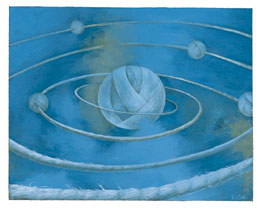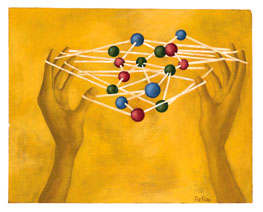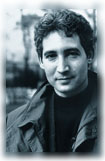Main Menu · Search ·Current Issue ·Contact ·Archives ·Centennial ·Letters to the Editor ·FAQs
One StuffNature, naked in the extremeby Alan Lightman
|
In his great essay "Nature," Ralph Waldo Emerson wrote, "the whole code of her laws may be written on the thumbnail....so poor is nature with all her craft, that, from the beginning to the end of the universe, she has but one stuff...to serve up all her dream-like variety." Travelers, storytellers, anthropologists, even biologists seek the variety. But it is the one stuff that most attracts physicists, those practitioners of science who study nature in its most basic form. Indeed, the one primal essence, the master equation, has become the Holy Grail of modern physics.
And physicists have been increasingly audacious in the quest. In the 1930s, they took satisfaction in having reduced all of the pushes and pulls of the world to four basic forces: gravity, electromagnetism, and a "strong" and "weak" nuclear force. In the 1960s, four began seeming like a large number. Physicists succeeded in going to three. By the 1970s, three had dwindled to two, gravity and a "grand unified" force combining the others.
The Elegant Universe: Superstrings, Hidden Dimensions, and the Quest for the Ultimate Theory, by Brian Greene '84 (W.W. Norton, $27.95). |
In the last decade, theoretical "particle physicists" have been taking seriously the possibility of the ultimate reduction: all of the forces of nature together with all of the elementary particles in terms of a single lone entity, naked in the extreme, the fundamental of the fundamentals, a single kind of primal object that determines all else in the world. One can view this program either as the worst nightmare of the deconstructionist critics, who accuse science of being laughably reductionist, or as the highest poetry that the human spirit can conceive.
To embark on this ultimate journey, particle physicists have changed their name to string theorists, for the fundamental entity turns out to be not a particle like the electron, infinitely small and of zero dimensionality, but a string, like a rubber band, infinitely thin but with a tiny bit of length. The typical length of one of these hypothesized primal strings is 10-33 centimeters, one hundredth of a billionth of a billionth of the size of the nucleus of an atom. A primal string is smaller than an atomic nucleus by the same factor that an atomic nucleus is smaller than Rhode Island. According to the theory, all of these ultrasmall strings are identical. But each of them can vibrate in different ways, similar to the vibrations of a guitar string, and the different notes thus produced create all the different forces and particles in nature. One pattern of vibration corresponds to the gravitational force, another corresponds to the electron, and so on.
String theory is still in its infancy. It is also among the most mathematical and difficult areas of all theoretical physics. For these reasons, only a few brave souls have attempted to write popular books on the subject--Beyond Einstein: The Cosmic Quest for the Theory of the Universe (1987), by Michio Kaku '68; Theories of Everything (1992), by John Barrow; Dreams of a Final Theory (1992), by Steven Weinberg, Morris Loeb visiting professor of physics. In my opinion, Brian Greene's new Elegant Universe is the clearest and most comprehensive of these books. It is certainly the most up-to-date. (A great deal has happened in string theory just since 1995; five years from now, we will need A More Elegant Universe.) After providing fresh introductions to quantum theory and gravitation theory, Greene takes string theory from its beginnings right up to the present, including current dilemmas and future directions. A former Rhodes Scholar and now professor of physics and mathematics at Columbia University, Greene is a leading string theorist himself. He thus joins a recent trend in which scientists at the cutting edge of their fields are writing their own books for the public. Making prolific use of analogies to convey arcane ideas, Greene writes with intelligence, wit, and a dramatic flair that reminds me of the books of MIT's psycholinguist Steven Pinker. The only possible flaw with this excellent book might be that its author attempts to do too much, giving glossed-over explanations of even those details that require a large background in physics to grasp. Still, readers can have the satisfaction of at least hearing all the words and ideas, even if some are incomprehensible.

|
Here, I must digress to explain the importance of incorporating gravity into string theory, perhaps the greatest triumph of all. Gravity is the most subtle of all the four forces, for it affects the geometry of space and time, the very stage of reality on which the other forces of nature play out. For decades, physicists had attempted in vain to formulate a "quantum" theory of gravity. Einstein's 1915 theory of gravity, called general relativity, is not quantum, it is "classical," meaning that it follows the pre-twentieth-century notions of matter and energy. In particular, according to classical physics, a particle of matter has a definite position and velocity at each moment in time. Once these data are known, together with the laws of physics and locations of other particles, the future position and velocity of the particle can be calculated to any accuracy desired. This classical view of reality is highly deterministic: the condition of the universe at any moment determines its condition at all future moments. But quantum physics, formulated in the 1920s and 1930s and since verified by numerous experiments, introduced an essential indeterminism into nature. In the quantum world, particles necessarily exist in many places at once, and their future motions can be followed not with certainties but only with probabilities. These quantum ideas seem extremely strange to us because they are not noticeable in the macroscopic world of our daily existence. But in the subatomic world, they are large and very real. All modern theories of physics, including string theory and the grand unified theories, are quantum theories--that is, they have been formulated in the probabilistic mathematics and language of quantum physics. Physicists have long known that Einstein's general relativity must eventually be revised and reformulated into a quantum theory. Furthermore, without a quantum theory of gravity, it would be impossible to propose a superunified theory encompassing all the four forces, a prospect that brings ecstacy to the physicist's heart.
Why did a quantum theory of gravity elude the greatest minds in physics for so long? In part because of the highly chaotic behavior of "empty" space at ultrasmall length scales. According to quantum theory, truly empty space does not exist. Subatomic particles can appear out of nothing for brief periods of time and then annihilate each other. Yet classical general relativity, which deals precisely with how the geometry of space and time is altered by matter and energy, demands an empty or at least smooth region of space around each piece of matter, to give meaning to a smooth background of space and time against which changes can occur. On merely atomic scales of distance, the continual creation of subatomic particles and energy averages out to a smooth background hiss, causing little problem. But the quantum grittiness and misbehavior become more and more violent at smaller and smaller scales. On ultrasubatomic scales, such quantum activity causes sudden and large distortions that destroy the requirements of general relativity, destroy even the ability to define time and space. The replacement of particles by strings saves the day because strings, unlike point particles, have a slight spatial size. This finite size of the smallest constituents of matter, like a minimum-sized grain of sand on a beach, limits the quantum grittiness on the smallest and most violent scales. That is why a quantum string theory and gravity can coexist together, producing a quantum theory of gravity.
The string theory of the 1970s had many technical problems and was ignored by most physicists. However, Schwarz and a small number of coworkers persisted in their efforts. Schwarz later commented that "the mathematical structure of string theory was so beautiful and had so many miraculous properties that it had to be pointing toward something deep." Then, in 1984, Schwarz and Michael Green of Queen Mary College in London eliminated some of the problems and further showed that the various vibrational patterns of strings could account for all of the forces and particles. Once a small number of properties of the identical strings, such as their tension, are known, the rest (of the universe) follows. In principle, the many input parameters of all previous theories in physics, such as the masses of electrons and quarks, formerly taken necessarily as givens, can now be calculated from scratch from the vibrational patterns of strings. As Greene suggests, even deeper questions might be answered by string theory, such as why space has three dimensions. That is why many physicists have called string theory the Theory of Everything (TOE).
One must understand that not a shred of experimental evidence exists today for string theory. The theoretical calculations are far ahead of our ability to test them. And any tests in the future will necessarily be indirect. To probe strings themselves would require colossal energies, beyond any particle accelerators we could ever build. At present, string theory rests entirely on the fervent desires of theoretical physicists who, like Schwarz, see it as beautiful. The requisite equipment at the disposal of these theoretical physicists includes pencils and paper, computers, and plenty of wastebaskets. And the mathematics is so difficult that the equations cannot be solved, or even formulated, except in approximate form. Thus, as Greene sheepishly admits, no definite predictions have yet been announced. Current string theory, as brilliant as it may be, has not yet yielded applications. Current string theory is a hundred-dollar bill in a Laundromat.
One of the most curious aspects of string theory, involving much of current research, is that the theory requires at least six spatial dimensions beyond the familiar three. We don't see the extra dimensions because they are curled up into ultratiny loops, too small to experience. To us macroscopic creatures, unimaginably larger than strings, the extra, curled-up dimensions are undetectable. Similarly, a garden hose would appear one-dimensional at a distance of a hundred feet; from so far away, its thickness, curled around in a diameter of an inch, would be invisible. Evidently, there are many thousands of possibilities for the shapes and structures of the extra dimensions of string theory, which are called Calabi-Yau spaces. ("Yau" honors earlier theoretical work by Higgins professor of mathematics Shing-Tung Yau.) A simple analogue of a Calabi-Yau space in two dimensions is the surface of a sphere; two numbers, latitude and longitude, are needed to specify each location in the "space."
The six curled dimensions in string theory offer a number of complications, not least of which is that each of the many possible Calabi-Yau spaces produces a dif-
ferent version of the theory, with correspondingly different physical predictions. Yet we do not know which of the Calabi-Yau spaces corresponds to reality. The situation is akin to searching a telephone book for a person whose last name is Smith, but whose first name you have forgotten.
Here, we are treated to a flavorful taste of some of Greene's own research. With a number of colleagues, Greene has shown that each Calabi-Yau six-dimensional space can be paired with a companion Calabi-Yau space, called a mirror space, with identical physical properties. Thus, the many Calabi-Yau spaces are not as different as they seem. There are relationships between them.
In 1992, Greene and two colleagues from Duke University, David Morrison, Ph.D. '80, and Paul Aspinwall, showed that mirror spaces can actually transform into each other (in a process called "space-tearing flop transitions"), pointing to even further connections between the many seemingly disparate Calabi-Yau spaces. Greene is principally a physicist while Morrison is principally a mathematician. To collaborate, each needed to take a crash course in the other's discipline. In the evenings, after a full day of work, they took turns lecturing each other for an hour or two. Greene describes the other member of the team, Paul Aspinwall, a "curious mixture of upper-class British sensibility...infused ever so slightly with a prankster's roguishness," as the most civilized physicist he knows because Aspinwall, unlike most scientists who work deep in the night and on weekends when bitten by a problem, packs up his pencil and paper promptly at 5 p.m. Unfortunately, it was late one Friday night when Morrison and Greene were ready for the last step of their calculation, poised to answer the question of whether spatial tears can occur in the fabric of the universe. And they could not take that final step without Aspinwall and his computer code. They called Aspinwall at home. At first, he refused to violate his weekend. But "after much groaning" and a promised six-pack of beer, he relented.
Such personal stories of Greene's work and that of other string theorists add color to The Elegant Universe and offer a valuable portrait of how scientists collaborate and build upon each other's work. Perhaps the most impressive of all the string physicists is Edward Witten, Jf '80, of the Institute for Advanced Study in Princeton, New Jersey. Witten, quiet and painfully shy, has been at the center of string theory for the last 15 years and, besides continually defining the direction of new research, makes remarks like "String theory is a part of twenty-first-century physics that fell by chance into the twentieth century." Witten is widely considered the smartest physicist in the world. His wife, also a physicist, describes how he sits at the kitchen table thinking about string theory, only now and then reaching for a pen and paper to check a detail. (Years ago, Witten once walked into a class I was teaching at Harvard on the structure of stars. At the time, he would have been in his mid twenties and had, I am sure, never opened an astronomy book in his life. He raised his hand and pointed out some error I was making, in a voice so soft as to be almost inaudible. Then he quietly left, never to return.)
At a 1995 conference at the University of California, Witten stunned the international string community by announcing a mega-string-theory called M-theory. For the cost of only one more dimension (raising the number of curled-up, hidden dimensions of space from six to seven), Witten was able to show a deep connection between all of the various versions of string theory. Prior to Witten's work, string theorists were faced with five different string theories, over and above the variations caused by the Calabi-Yau spaces, causing confusion and embarrassment. M-theory (where some say the "M" stands for "Mother," others for "Mystery") merges all of the theories into a unified framework. M-theory could be the final theory.
 Brian Greene. Dan Deitch
Brian Greene. Dan Deitch |
Most theoretical physicists hope that there is no freedom at all, that when the final string theory, or M-theory, or Theory of Everything is found, it and all of its parameters will be what they are by some ruthless necessity. Opposing this view is the fascinating idea that many different kinds of universes are logically possible and, according to calculations by physicist André Linde and others, are in fact constantly coming into existence. These many different universes, called collectively the multiverse, would have very different basic properties. Some would have loose strings, some would have taut strings. Some would have heavy electrons, some would have light ones. Some would have three extended spatial dimensions like ours, some might have 27. But, according to a notion called the anthropic principle, only a tiny fraction of these universes would have conditions able to create life. Thus, the fact that we exist to ask questions and do physics and write essays means that our universe is one of that small, life-supporting fraction of possible universes. In this view, the degree of tautness of strings in our universe is not what it is out of logical necessity but simply by accident. Different universes come into existence randomly, like the flicker of fireflies on a summer night. Some create life, most do not. And we, by tautology, live in a universe that contains life. We, and our universe, are an accident.
If we are indeed an accident, what does that mean? Accidents lack the comfort of necessity. Accidents place things off balance, accidents agitate, accidents unsettle and raise questions. Should we live our lives differently, knowing that we could be an accident? For those who believe in a divine purpose, how is that purpose altered? What is the significance of the countless other universes, spinning on and on into eternity? I wonder whether Emerson would have been distressed by the possibility that our universe is an accident. Yet each accident can have its own grandeur and perfection. Emerson may have still wanted to write the opening line of his essay: "There are days which occur in this climate, at almost any season of the year, wherein the world reaches its perfection, when the air, the heavenly bodies, and the earth, make a harmony...."